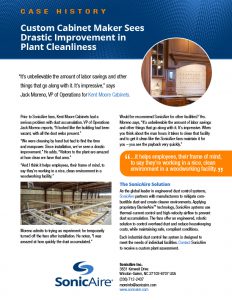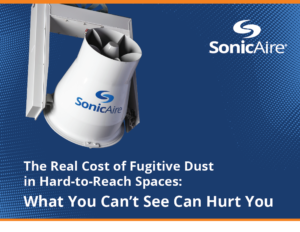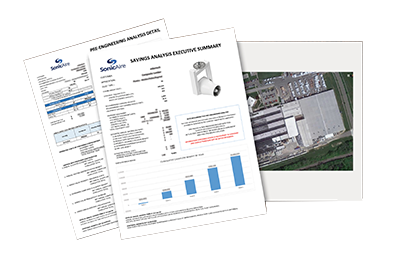Kent Moore Cabinets
Prior to SonicAire fans, Kent Moore Cabinets had a serious problem with dust accumulation. VP of Operations Jack Moreno reports, “It looked like the building had been vacant, with all the dust webs present.”
“We were cleaning by hand but had to find the time and manpower. Since installation, we’ve seen a drastic improvement.” He adds, “Visitors to the plant are amazed at how clean we have that area.”
“And I think it helps employees, their frame of mind, to say they’re working in a nice, clean environment in a woodworking facility.”

Would he recommend SonicAire for other facilities? Yes. Moreno says, “It’s unbelievable the amount of labor savings and other things that go along with it. It’s impressive. When you think about the man hours it takes to clean that facility and to get it clean like the SonicAire fans maintain it for you – you see the payback very quickly.”
Iowa State University
Kent Feed Mill
At Iowa State University’s Kent Feed Mill and Grain Science Complex, the first university-owned feed mill in Iowa, dust control was a crucial consideration from the start. Dr. Dirk Maier, Professor and Director of Agricultural Biosystems Engineering at ISU, acknowledges the inevitable challenges of dust in their operations: “Anytime you open up a bag, you open up a tote, you do some hand mixing operation… some will become fugitive.”
The facility implemented SonicAire dust control fans as part of their comprehensive approach to dust mitigation, recognizing that effective dust control is paramount for both safety and operational efficiency.
“Anytime we have to sweep, that’s labor, right? And so labor is a high-cost component of feed manufacturing,” notes Professor Maier, highlighting the economic impact of dust control in their operations.
The complex serves as both a training ground for students and a hub for cutting-edge research in feed and grain technology. By incorporating advanced dust control systems like SonicAire, ISU has created a safer, more productive environment that better represents real-world industry conditions.
Through their partnership with SonicAire, ISU isn’t just solving a dust problem – they’re setting a new benchmark for agricultural education facilities nationwide. The investment in automated dust control technology has delivered immediate returns in safety, efficiency, and reduced labor costs, while demonstrating to the next generation of agriculture professionals what a state-of-the-art, well-maintained facility should look like. It’s a clear example of how innovative dust control solutions can transform both educational and industrial environments.

GET YOUR FREE GUIDE:
The Real Cost of Fugitive Dust in Hard-to-Reach Spaces
What You Can’t See Can Hurt You
To help protect your workplace, we’ve compiled the following resource, The Real Cost of Fugitive Dust in Hard-to-Reach Spaces: What You Can’t See Can Hurt You. In it, we identify seven ways fugitive dust is likely impacting your facility and its profitability.
These costs go beyond housekeeping and explain why you should be preventing dust buildup to protect the bottom line, not just to stay in compliance.

